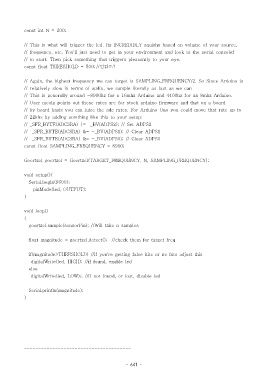Page 641 - 3-2
P. 641
const int N = 200;
// This is what will trigger the led. Its INCREDIBLY squishy based on volume of your source,
// frequency, etc. You'll just need to get in your environment and look at the serial consolef
// to start. Then pick something that triggers pleasantly to your eye.
const float THRESHOLD = 500; 민감도// ?
// Again, the highest frequency we can target is SAMPLING_FREQUENCY/2. So Since Arduino is
// relatively slow in terms of audio, we sample literally as fast as we can
// This is generally around ~8900hz for a 16mhz Arduino and 4400hz for an 8mhz Arduino.
// User nicola points out these rates are for stock arduino firmware and that on a board
// by board basis you can juice the adc rates. For Arduino Uno you could move that rate up to
// 22khz by adding somthing like this to your setup:
// _SFR_BYTE(ADCSRA) |= _BV(ADPS2); // Set ADPS2
// _SFR_BYTE(ADCSRA) &= ~_BV(ADPS1); // Clear ADPS1
// _SFR_BYTE(ADCSRA) &= ~_BV(ADPS0); // Clear ADPS0
const float SAMPLING_FREQUENCY = 8900;
Goertzel goertzel = Goertzel(TARGET_FREQUENCY, N, SAMPLING_FREQUENCY);
void setup(){
Serial.begin(9600);
pinMode(led, OUTPUT);
}
void loop()
{
goertzel.sample(sensorPin); //Will take n samples
float magnitude = goertzel.detect(); //check them for target_freq
if(magnitude>THRESHOLD) //if you're getting false hits or no hits adjust this
digitalWrite(led, HIGH); //if found, enable led
else
digitalWrite(led, LOW);; //if not found, or lost, disable led
Serial.println(magnitude);
}
--------------------------------------
- 641 -

